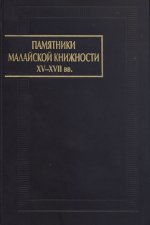
|
Monuments of Malay Book Culture from 15th to 17th Century. The Story of the Victorious Pandawas; Bukhari al-Jauhari. Crown of Sultans [Памятники малайской книжности XV-XVII вв.: Повесть о победоносных Пандавах ; Бухари ал-Джаухари. Корона царей]. Tr. from Malay, Research, Notes and Indices by L.V.Goryaeva. Moscow, Vostochnaya Literatura Publishers, 2011. 646 p. (Pamyatniki pismennosti Vostoka, CXXXVII).
I.
Hikayat Pandawa Jaya
SUMMARY
It is common knowledge that the Indian Mahabharata had an exceptional influence on the literary creation in the insular South-East Asia, actually inspiring a number of epic poems (kakawiri) and prose literary works (parwa)
in Old Javanese. Moreover, most of the traditional Malay and Javanese wayang (shadow-theater) repertoire is based on the Mahabharata story or, at least, uses the principal characters of the Indian prototype.
The first Malay version of the Mahabharata known under the title of Hikayat Pandawa Jaya (“The Story of the Victorious Pandawas”) is a patch
work of episodes and scenes of different origin. The main part of its story is based on the Old Javanese kakawins — Bharatayuddha and Ghatotkacagraya (12th century), framed by a number of lakon (plays) from the wayang reper
toire and interlaced with some motives taken from the Javanese epic poems of the Majapahit era. According to some indirect data, the roots of the
Hikayat Pandawa Jaya can be traced to a supposed Middle Javanese prototype — an adaptation of the Bharatayuddha bearing the name of Pandawa
Jaya and dated, most probably, to the late 14th — early 15th century.
There is no doubt that the passage of the Mahabharata story from Javanese epic and theatrical traditions into Malay narrative prose has been a complex creative process. The text of the Hikayat Pandawa Jaya bears traces of
kakawin figurative style, as well as a number of features proper to the wayang tradition — staging, scenery, succession of episodes. Woven together in one continuous narration, all these elements were bound into an organic
whole — an epic cycle about heroic deeds of the Pandawas — legendary ancestors of Javanese kings.
Despite the Hindu-Javanese origin of its story, the Malay Hikayat Pandawa Jaya, taken as a whole, appears as an original composition, one of the
earliest Malay fictional narratives displaying most of the characteristics of the
hikayat genre.
II.
Taj as-Salatin
SUMMARY
Composed in 1603, the book of counsel Taj as-Salatin (“Crown of Sultans”) became the first in the Malay world and the most outstanding speci
men of the Mirror-for-princes genre, widespread all over the Arab-Muslim cultural area. The book spoke about the qualities required of a ruler, the way of carrying on the functions of the head of state, and reflected the growing interest of Malay Muslim elites for literatures and history of Muslim countries as well as their special concern for including the Malays into the main
stream of Islamic culture.
Up to the latest times, students of the Malay written tradition had no proved evidence whether Taj as-Salatin was an authentic Malay composition, created under Arab or Persian influence, an imitation or a mere translation of
an unknown Persian mirror. Its author, of whom only the name — Bukhari al-Jauhari — is known, refers to about fifty Arab and Persian adab works he used when writing his book, from which he picked up a number of short stories illustrating the main topic of each chapter.
Despite the abundance of references used by Bukhari, almost all of them (hadiths and Quranic quotations excluded), turned out to be not authentic.
The basic sources, actually used but never mentioned by the author, were two books by one of the greatest Muslim thinkers, Abu Hamid al-Ghazali (1058-1111) — Nasihat al-Muluk (“The Book of Counsel for Kings”) and Kimiyya-
yi sa ‘adat (“The Alchemy of Happiness”). From all the other references mentioned by Bukhari the only authentic ones were 'Aqaid (“The Creed of
Islam”) by Najm ad-Din an-Nasafi (d. 1142) and the so-called Ahd-name Umar (“Pact of Umar”) taken, most probably, from another didactic treatise, Siraj al-Muluk (“The Light of Kings”) by al-Ghazali’s contemporary and rival — Muhammad ibn Walid at-Turtushi (1060-1126). It is evident,
therefore, that for Bukhari the main sources of inspiration and examples to follow were not the Persian mirrors of the Mughal era, as it was generally supposed, but mostly the religious, philosophical and political writings of the
12th century.  PDF-files PDF-files
Аннотация, Предисловие издателя, Содержание; Повесть о победоносных Пандавах: Предисловие [начало], Summary; Корона царей: Предисловие [начало], Summary
Keywords
Bukhari al-Jauhari
Hikayat Pandawa Jaya
Malay literature
Taj as-Salatin
|

